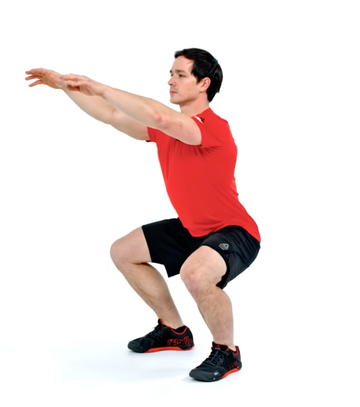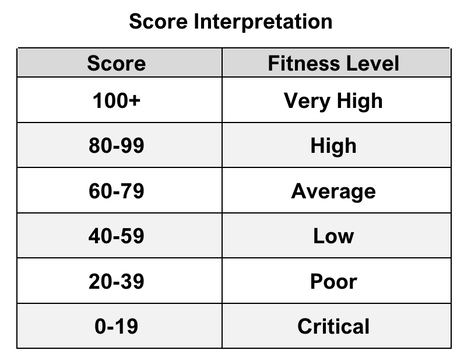Med-Fit Tech Assistant
Medical-Fitness Assessment - Learning Module #8
Muscle Fitness
Part A
Part A: Leg Muscle Fitness
Learning Objective:
Learning Objective:
- Properly conduct the Squat Test
- Calculate the Leg Fitness Score
The Squat Test for Leg Muscle Fitness is a 3-minute AMRAP (as many reps as possible) during which the participant tries to perform as many squats as possible (to the best of his/her ability) until the time runs out.
The squat exercise mainly targets the Gluteus Maximus and the Quadriceps Femoris muscles.
The squat exercise mainly targets the Gluteus Maximus and the Quadriceps Femoris muscles.
Know how to do a Squat.
(Tap/Click the photo to watch the video on Youtube.)
(Tap/Click the photo to watch the video on Youtube.)
Squat Instructions:
- Shoulder-width stance
- Knees in line with toes
- Lumbar curve maintained (by keeping the chest up)
- Hips descend back and down
- Raising the arms as the hips go down may help maintain balance
- Hips descend lower than knees
- Heels down
- Complete at full hip and knee extension
Test Instructions:
- Make sure the participant has a firm, level surface with plenty of space.
- Demonstrate how to perform a squat by doing several of them, but pausing to explain the body movements.
- Have the participant perform a squat to the best of his/her ability.
- The participant should lower his/her hips only as low as it is comfortable for them and still be able to stand back up.
- Explain that they can stop and rest if needed, but if they do, the clock keeps running.
- Instruct the participant that when they are told the 3 minutes has expired, they should "note the rep count," but they should not stop or sit down, but rather, they should "walk around" for a few minutes as their leg muscles relax and their heart rate recovers.
- Let the participant practice a few squats as a warm-up.
- Explain that you will start the clock when he/she is ready to start the test.
Test Protocol:
- Stand several feet away from the participant so that you can observe the complete squat movement.
- Confirm that the participant understands the squat movement and the test procedure.
- After the participant has warmed up, ask him/her to indicate when he/she is ready to begin.
- Start a hand-held 3-minute timer when the participant begins doing his/her first squat.
- Count out loud each completed Squat at the standing position.
- Observe the participant at all times and check their body movements.
- Especially note the depth of their hips in relation to their knees.
- Do not inform the participant how much time is remaining on the clock.
- At the end of the last squat at the 3-minute mark, say out loud: "Stop."
- Record the total number of completed Squats during the 3-minute test.
Scoring the Test Result:
- Divide the total number of Squats by 120 and then multiply that number by 100.
- Round off to the nearest 0.1 decimal point.
- Example: Total Reps = 94 squats. (94 / 120) x 100 = 78.3 (Raw Rep Score)
- Grade the participants ability to perform the standard squat:
- -- A = Lowered their hips consistently to flex their knees 90 or more degrees. (Thighs parallel or beyond to the floor.)
- -- B = Lowered their hips more consistently to flex their knees less than 90, but more than 60 degrees.
- -- C = Lowered their hips more consistently to flex their knees less than 60, but more than 45 degrees.
- -- D = Lowered their hips more consistently to flex their knees 45 degrees or less.
- Adjust the participant's Raw Rep Score by their Grade to get their Leg Fitness Score:
- -- A: Raw Rep Score = Leg Fitness Score (no grade adjustment)
- -- B: Raw Rep Score - 10% = Leg Fitness Score
- -- C: Raw Rep Score - 25% = Leg Fitness Score
- -- D: Raw Rep Score - 50% = Leg Fitness Score
- Example: 78.3 Raw Fitness Score with a C Grade = 78.3 - 25% (78.3 x 0.25 = 19.6) = 78.3 - 19.6 = 58.7 Leg Fitness Score
Leg Fitness Score Interpretation:
- A Leg Fitness Score of 100 (or more) indicates a Very High Fitness Level
- Scores above 100 are admirable, but they do not necessarily confer a health or longevity benefit.
- Since the fitness test is sub-maximal, scores above 120 are not necessarily comparable.
- A Leg Fitness Score below 100 indicates "room for improvement," depending on the age of the participant.
Note: An “average” fitness level among an unfit and unhealthy population that is at increased risk for sedentary-related chronic disease resulting in premature disability and death is not satisfactory.

